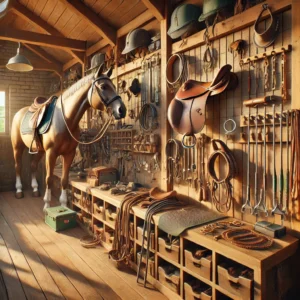
0 - $0.00
- 0 items
- view cart

Stepping into the tack shop can feel like navigating a foreign language. Saddles, bridles, bits, boots – the endless rows of equipment overwhelm even seasoned riders. But choosing the right gear for your horse isn’t just about aesthetics; it’s about ensuring their comfort, well-being, and optimal performance. So, saddle up and let’s embark on a journey through the essentials of equine attire!

The golden rule of tack selection is fit, fit, fit!. An ill-fitting saddle can pinch, rub, and restrict movement, potentially leading to pain and behavioral issues. Always prioritize proper fit over brand names or aesthetics. Consult a qualified saddle fitter who can evaluate your horse’s conformation and recommend saddles that distribute weight evenly and comfortably. Remember, “one size fits all” never applies in the equine world.
The saddle forms the foundation of your riding experience, so choose wisely. English disciplines like dressage and jumping require different saddle styles than Western riding or trail adventures. Consider your riding style and horse’s build when selecting a saddle, ensuring it offers adequate support and allows for balanced movement. Remember, a properly fitted saddle shouldn’t require excessive cinching or padding to stay secure.
The bridle serves as your communication tool with your horse. Choose a bridle style appropriate for your discipline (dressage bridles differ from Western headstalls) and ensure it fits comfortably around your horse’s head. Avoid overly tight nosebands or restrictive browbands that could impede breathing or vision. The bit, the metal mouthpiece within the bridle, plays a crucial role in communication. Consult a trainer or experienced rider to select a bit that suits your horse’s sensitivity level and training stage. Never force a bit that causes discomfort or resistance.
While the saddle and bridle are the primary players, additional equipment might be necessary depending on your riding activities. Leg protection like boots or wraps can shield your horse’s legs from impacts during jumping or trail riding. Blankets keep them warm in colder climates, while fly sheets offer protection from pesky insects. Remember, choose gear based on your horse’s individual needs and the specific demands of your riding discipline.
Safety should never be an afterthought. Invest in a well-fitting helmet that meets current safety standards, and don’t forget sturdy riding boots with proper ankle support. Consider reflective gear for low-light visibility, and ensure your saddle has sturdy stirrups and leathers that can withstand your weight and riding style. Remember, your safety is just as important as your horse’s, so prioritize protective gear that inspires confidence and peace of mind.
Horseback riding can be an expensive hobby, but that doesn’t mean you have to break the bank on equipment. Consider exploring second-hand tack shops, online marketplaces, or tack consignment stores. With careful inspection and proper cleaning, you can find quality used gear at a fraction of the original price. Remember, good condition matters more than brand names – prioritize fit and functionality over flashy labels.
Choosing the right equipment is a collaborative effort between you, your horse, and potentially a qualified professional. Listen to your horse’s responses to different gear options, observe their comfort level, and don’t hesitate to seek expert guidance when needed. Remember, the perfect tack complements your horse’s unique needs and enhances your riding experience, paving the way for a safe, enjoyable, and harmonious partnership.
So, the next time you’re faced with the vast array of horse gear, remember: prioritize fit, prioritize function, and prioritize safety. With a little research, some expert advice, and a good understanding of your horse’s needs, you’ll be able to confidently navigate the world of tack and choose equipment that sets you both up for success in the saddle!
Don’t miss our future updates! Get Subscribed Today!
©2025. Bar BJ Products All Rights Reserved.